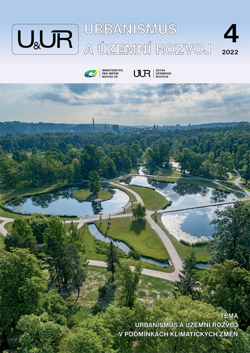
Modeling of the potential impacts caused by newly planted trees in street canyons, by Jan Geletič, Martin Bureš, Pavel Krč, Jaroslav Resler, Hynek Řezníček, Mária Kazmuková and Andrea Šipanová
Cities in times of climate change – one of the most current and probably the most complex challenges that local governments have to face. Although a large number of adaptation strategies and climate plans have emerged recently, many have a common outcome; the simplest and most economically advantageous solution is urban greenery, especially trees. Urban greenery in public space is perceived as an essential element of cities and its impacts are automatically accepted by the public as positive. The negative effects of greenery in the urban environments, apart from possible allergies, practically are not reflected or considered by urban planners at all. However, the environmental impact of trees in city streets, both positive and negative, represents a significant consequence of adaptation policies, as well as their cost-benefit ratio. The results of newly developed and validated microclimate models can be used to assess the potential impact of tree planting on pedestrian level. Due to the high level of detail, they can provide a new insight into the processes in the street canyon and bring a new perspective for a comprehensive assessment of adaptation measures. The paper aims to: I) explain and summarize the basic principles and differences between the models; II) describe the direct and indirect links between the variables and III) interpret the latest knowledge about the positive and negative effects of greenery in the street space on the example of two scenarios in Prague-Dejvice.
Current approaches to the adaptation of settlements to climate change in the context of spatial development, spatial planning and urban planning, by Petr Klápště, Petr Pavelčík and Miroslav Lupač
A combination of concentrated population, economic activities and the heat island effect has intensified various impacts of climate change on settlements, particularly cities. We have been working on climate strategies in the Czech Republic for several years, pinpointing the interconnection between adaptation and mitigation measures such as green infrastructure.
We are convinced that efficient adaptation of urban territories depends directly on the coordination of spatial development, protection of values and promotion of public interest. The tools of spatial planning are indispensable in many respects.
Prague’s green and blue future in the context of the Climate Plan until 2030, by Tereza Líbová
Combatting climate change is like two faces of the same coin: we actively strive to forestall ongoing climate change and reduce the level of greenhouse gases while aiming to cope with irreversible damage that has already been caused and adapt ourselves to it. This article deals mainly with the Prague Climate Plan until 2030 in the context of climate change adaptation.
The Strategic Plan of the City of Plzeň and its preparations for climate change, by Eva Velebná Brejchová
The Strategic Plan of the City of Plzeň communicates an idea of a city’s future and shows a clear path towards implementation of this idea, which is necessary for each individual, enterprise and city to ensure that they are not caught out by the pace of events. The main objective is to improve the living conditions of inhabitants, propose steps necessary for sustainable urban development and provide businesses and the public with information on long-term development plans. As for adaptation measures and climate change, the city of Plzeň is doing its utmost to prevent impacts of heat islands. These efforts are based on projects for a stronger green and blue infrastructure comprising rainwater management, general revitalization of public areas and quality improvement in urban greenery.
Olomouc: elaboration of the adaptation and mitigation strategy of the city, by Ludmila Žaláková & Jiří Jedlička
The statutory city of Olomouc has officially become part of the Mayors’ Pact, an initiative of representatives that strives to reduce CO2 emissions and polluting substances by means of a decrease in fuel consumption and use of renewable energies. At the same time, the city wants to strengthen its self-sufficiency in energy, adapt for climate change and create adequate areas of public greenery complemented by water elements (green and blue infrastructure). For reconstructions as well as new constructions, the city intends to apply requirements for low energy consumption and, wherever possible, use renewable energies. Suitable adaptation measures will be applied to increase the quality of housing. This article summarizes the process of preparation, elaboration and approval of Adaptation and Mitigation Strategy of the City of Olomouc, a document financed by a subsidy from the project SGS-3 ‘Oslo’ provided by the State Environmental Fund of the Czech Republic within Norway Funds 2014–2021.
Adapting to climate change in Uherské Hradiště, by Jaroslav Bičan & Martin Ševčík
Scientists, writers systematically dealing with the dynamics of collapse, and authors of various civilian and military prognoses have long been warning us of the dangers of climate change. Rather than a discussion on reasons, a detailed analysis of impacts on particular branches or an enumeration of commonplaces regarding challenges presented by climate change, this article aspires to outline possible reactions to these phenomena in the field of spatial development as based
on the conditions of a particular territory.